
GINZA CONNECTIVE
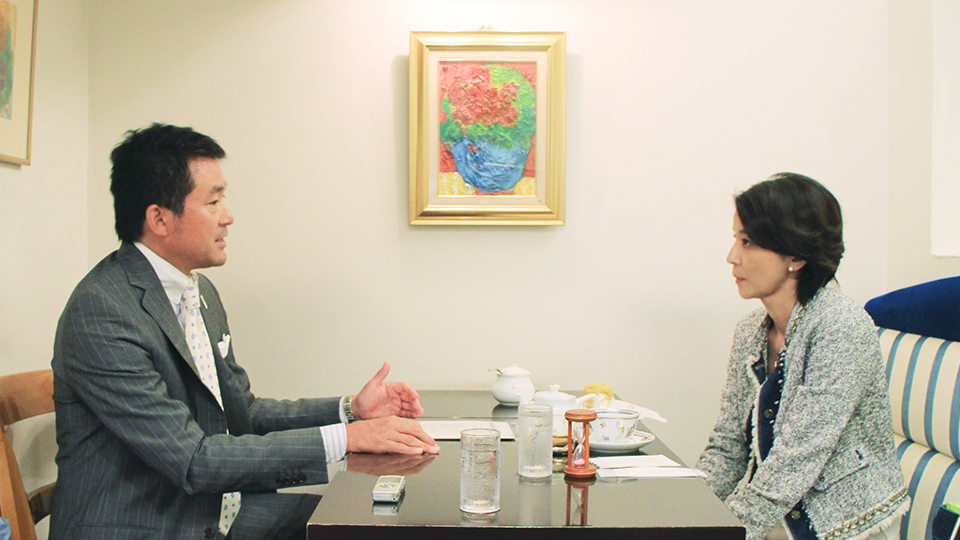
GINZA CONNECTIVE VOL.27
Koichi Suzuki×Chisako Takashima
2013.12.06
A talk series with the violinist Chisako Takashima and the Ginza people. Ginza holds many personal and professional memories for Takashima. In this talk series, she thoroughly explores various aspects of the Ginza culture with her guests. Today’s guest is Koichi Suzuki, president of Café de Ginza Miyuki-kan, one of the most well-known cafés in Ginza.
Café de Ginza Miyuki-kan that was opened by an ex-office worker who yearned for Ginza
- Takashima
- Your café first opened in 1969, which would make it a year younger than me. That is relatively young for a shop in Ginza, right?
- Suzuki
- Yes it is. It has been only 34 years since the café moved to Ginza, so it is just a baby compared to the veterans (laughs).
- Takashima
- Where was it before Ginza?
- Suzuki
- We had a shop on the first basement level of the Nihon Building in Otemachi, and moved here after it was open for 10 years. My predecessor originally worked at Nikko Securities, but he worked as a general manager of the Ginza office on the corner of Namiki-dori and Harumi-dori, and experienced the greatness of Ginza there. Apparently he had been wanting to someday open a shop in Ginza.
- Takashima
- So your father is an escaped office worker?
- Suzuki
- Yes. He quit his job when he was 40 and started up his own business. I was born the same year as the business.
- Takashima
- So you are the same age. By the way, where did the name of the shop come from?
- Suzuki
- The name of the building of the main café is Miyuki-kan.
- Takashima
- Now you have as many as six shops in Ginza.
- Suzuki
- That’s right. Each shop has its own theme and a menu and interior decor that suits its location. A common feature of all the shops is their white walls. The person who designed the interior decor was originally an artist who designed the shops each as their own painting. The customers come in against the white canvass to complete the painting. That is why all the shops have white walls. We maintain Ginza quality while taking care not to lose a sense of unity among the shops.
For the posts and other parts, we use old materials, for example pieces we hauled in that were actually used in old houses in Yamagata. - Takashima
- No kidding! Seeing the shop again from that perspective makes it all the more wonderful.
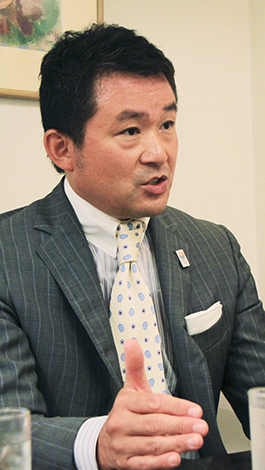
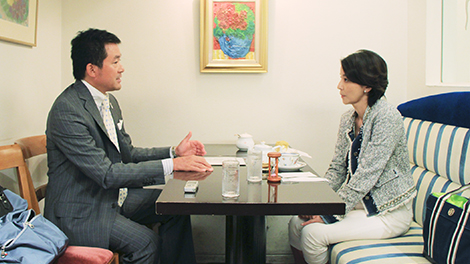
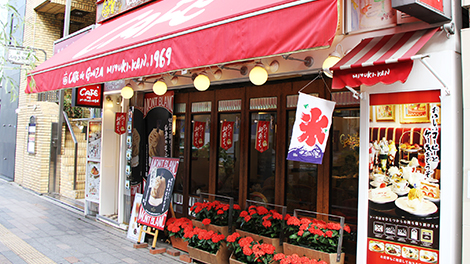
Café de Ginza Miyuki-kan Honten
The secret story behind the prized specialty Japanese chestnut mont blanc and its particular methods for creation
- Takashima
- Café de Ginza Miyuki-kan is famous for its Japanese chestnut mont blanc (cream cake). Have you had this on the menu since the shop first opened?
- Suzuki
- No, it has only been nine years since we first introduced it.
- Takashima
- So you, the second president, came up with the idea?
- Suzuki
- Well, not exactly. There was a pâtisserie in Minami-Azabu called La Precieuse (the Minami-Azabu shop is now closed) whose owner, Mr. Yamakawa, once worked at a cake factory we had in Shimbashi. He decided to go independent and open his own shop, and I went to his celebration party where me and my predecessor were given a Japanese chestnut mont blanc. It was so delicious that I asked Mr. Yamakawa if he would let us sell it at our shop, and we were able to make Japanese chestnut mont blanc cakes taught to us directly.
- Takashima
- So that is the story!
- Suzuki
- Since you are here, please try a Japanese chestnut mont blanc.
- Takashima
- I just love mont blanc. So much so that you would think it’s an illness (laughs). The color is a very elegant tone that could only be from a Japanese chestnut. (Takes a bite) Oh, delicious ♡ Makes me forget about work (laughs).
- Suzuki
- We may use the most Japanese chestnuts of all the western-style confectioneries in Japan. We use about 15 tons of Japanese chestnuts a year. The mont blanc you usually eat is a paste of French or Italian chestnuts mixed with whipped cream or other ingredients. Ours is simple, with only Japanese chestnut and sugar.
- Takashima
- Interesting. Where are the Japanese chestnuts from?
- Suzuki
- Our Japanese chestnuts are from Kuma in Kumamoto prefecture. If you don’t care where they are from, there are all types of chestnuts, but we searched for a chestnut with a great aroma and mild sweetness that was perfect for sweets, and the Kumamoto prefecture ones were the best. The shade varies slightly with the picking season. This is the season for new chestnuts, so the color is a lovely amber.
- Takashima
- I hear that more and more customers are coming specifically for this.
- Suzuki
- Gratefully, yes. We sell 200,000 a year.
- Takashima
- 200,000! That’s amazing! You must be pleased by the great profit (laughs).
- Suzuki
- Well the cost is pretty high (wry smile). But we refuse to compromise. The meringue is baked for 2 hours by the people at the factory, and we pipe out the unsweetened whipped cream and chestnut paste at the café. We make the meringue twice a day so that it doesn’t lose its crunch.
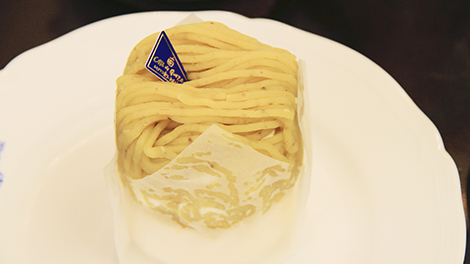
Ultra-popular Japanese chestnut mont blanc
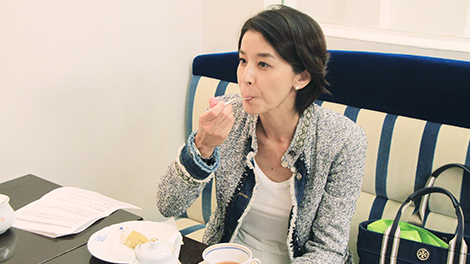
1 2
All List
- GINZA CONNECTIVE VOL.0 Ryo Sayegusa×Chisako Takashima
- GINZA CONNECTIVE VOL.1 Toshiyuki Kosaka×Chisako Takashima
- GINZA CONNECTIVE VOL.2 Yasuharu Mizuhara×Chisako Takashima
- GINZA CONNECTIVE VOL.3 Hitoshi Ishihara×Chisako Takashima
- GINZA CONNECTIVE VOL.4 Shinji Hara×Chisako Takashima
- GINZA CONNECTIVE VOL.5 Choichiro Motoyama×Chisako Takashima
- GINZA CONNECTIVE VOL.6 Noriko Okazoe×Chisako Takashima
- GINZA CONNECTIVE VOL.7 Choichiro Motoyama×Chisako Takashima
- GINZA CONNECTIVE VOL.8 Sayuri Yamaguchi×Chisako Takashima
- GINZA CONNECTIVE VOL.9 Yoshiki Tani×Chisako Takashima
- GINZA CONNECTIVE VOL.10 Yoshifumi Itoh×Chisako Takashima
- GINZA CONNECTIVE VOL.11 Kunihiko Miwa×Chisako Takashima
- GINZA CONNECTIVE VOL.12 Shin Watanabe×Chisako Takashima
- GINZA CONNECTIVE VOL.13 Akihiko Tsuda×Chisako Takashima
- GINZA CONNECTIVE VOL.14 Rie Horikawa×Chisako Takashima
- GINZA CONNECTIVE VOL.15 Jun Takahashi×Chisako Takashima
- GINZA CONNECTIVE VOL.16 Yusuke Harada×Chisako Takashima
- GINZA CONNECTIVE VOL.17 Lintaro Mizuhara×Chisako Takashima
- GINZA CONNECTIVE VOL.18 Keisuke Anzai×Chisako Takashima
- GINZA CONNECTIVE VOL.19 Hozu Yamamoto×Chisako Takashima
- GINZA CONNECTIVE VOL.20 Koji Shibata×Chisako Takashima
- GINZA CONNECTIVE VOL.21 Kayo Hosono×Chisako Takashima
- GINZA CONNECTIVE VOL.22 Mitsuru Saito×Chisako Takashima
- GINZA CONNECTIVE VOL.23 Akihisa Kawaguchi×Chisako Takashima
- GINZA CONNECTIVE VOL.24 Mamoru Sugiyama×Chisako Takashima
- GINZA CONNECTIVE VOL.25 Michiaki Kumagai×Chisako Takashima
- GINZA CONNECTIVE VOL.26 Shinichi Tanizawa×Chisako Takashima
- GINZA CONNECTIVE VOL.27 Koichi Suzuki×Chisako Takashima
- GINZA CONNECTIVE VOL.28 Munehito Matsuzaki×Chisako Takashima
- GINZA CONNECTIVE VOL.29 Hiroshi Hara × Chisako Takashima
- GINZA CONNECTIVE VOL.30 Shigeyuki Ando×Chisako Takashima
- GINZA CONNECTIVE VOL.31 Yukichi Ishikura × Chisako Takashima
- GINZA CONNECTIVE VOL.32 Seiko Yamada × Chisako Takashima
- GINZA CONNECTIVE VOL.33 Mami Nagai × Chisako Takashima
- GINZA CONNECTIVE VOL.34 Ryuta Takahashi × Chisako Takashima
- GINZA CONNECTIVE VOL.35 Kazumasa Osumi×Chisako Takashima
- GINZA CONNECTIVE VOL.36 Masahiro Kameoka×Chisako Takashima
- GINZA CONNECTIVE VOL.37 Shoichiro Watanabe×Chisako Takashima
- GINZA CONNECTIVE VOL.38 Keiji Niimoto×Chisako Takashima
- GINZA CONNECTIVE VOL.39 Chieko Nakamura ×Chisako Takashima
- GINZA CONNECTIVE VOL.40 Atsushi Yamane×Chisako Takashima
- GINZA CONNECTIVE VOL.41 Masaya Shibuya×Chisako Takashima
- GINZA CONNECTIVE VOL.42 Makoto Suzuki×Chisako Takashima
- GINZA CONNECTIVE VOL.43 Masaya Konaka×Chisako Takashima
- GINZA CONNECTIVE VOL.44 Masakazu Tanaka×Chisako Takashima
- GINZA CONNECTIVE VOL.45 Koko Kameoka × Chisako Takashima
- GINZA CONNECTIVE VOL.46 Jin Hirayama×Chisako Takashima
- GINZA CONNECTIVE VOL.47 Takashi Hoshihara×Chisako Takashima
- GINZA CONNECTIVE VOL.48 Mikiko Kimura × Chisako Takashima
- GINZA CONNECTIVE VOL.49 Keisuke Okamoto×Chisako Takashima
- GINZA CONNECTIVE VOL.50 Akira Ito × Chisako Takashima
- GINZA CONNECTIVE VOL.51 Tatsuhiko Adachi × Chisako Takashima
- GINZA CONNECTIVE VOL.52 Masahiko Yamano×Chisako Takashima
- GINZA CONNECTIVE VOL.53 Kiyoshi Kanazashi×Chisako Takashima
- GINZA CONNECTIVE VOL.54 Noriyuki Tsuji×Chisako Takashima
- GINZA CONNECTIVE VOL.55 Shoichi Kobayashi×Chisako Takashima
- GINZA CONNECTIVE VOL.56 Isao Nanjo×Chisako Takashima
- GINZA CONNECTIVE VOL.57 Shinobu Mitsuoka×Chisako Takashima
- GINZA CONNECTIVE VOL.58 Motoyoshi Yasuda×Chisako Takashima
- GINZA CONNECTIVE VOL.59 Toru Fujiki×Chisako Takashima
- GINZA CONNECTIVE VOL.60 Yuji Ida×Chisako Takashima
- GINZA CONNECTIVE VOL.61 Hitoshi Miki×Chisako Takashima
- GINZA CONNECTIVE VOL.62 Takehiko Furuya× Chisako Takashima
- GINZA CONNECTIVE VOL.63 Naoki Yoshizawa×Yusuke Yoshizawa×Chisako Takashima
- GINZA CONNECTIVE VOL.64 Kazuhito Kawase × Chisako Takashima
- GINZA CONNECTIVE VOL.65 Toshiji Yuki× Chisako Takashima
- GINZA CONNECTIVE VOL.66 Hikoyuki Yamaguchi×Chisako Takashima
- GINZA CONNECTIVE VOL.67 Daisuke Nagano×Chisako Takashima
- GINZA CONNECTIVE VOL.68 Shuichi Motohashi× Chisako Takashima
- GINZA CONNECTIVE VOL.69 Shinpei Tonaka×Chisako Takashima
- GINZA CONNECTIVE VOL.70 Shinya Kanematsu × Sachiko Takashima
- GINZA CONNECTIVE VOL.71 Masataka Yano×Chisako Takashima
- GINZA CONNECTIVE VOL.72 Mitsuhiro Kurokawa× Chisako Takashima
- GINZA CONNECTIVE VOL.73 Ryo Saegusa×Chisako Takashima








